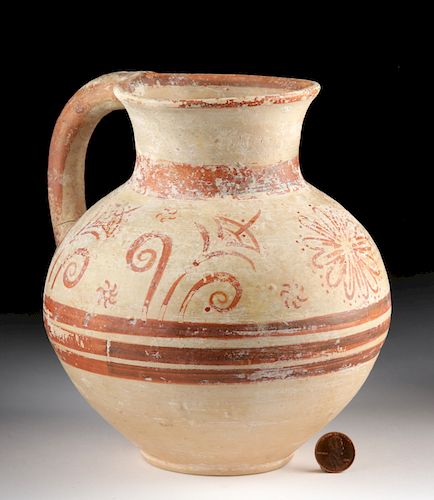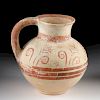Mycenean Bi-chrome Ewer - Papyrus Plants
Lot 43
About Seller
Artemis Fine Arts
686 S Taylor Ave, Ste 106
Louisville, CO 80027
United States
Selling antiquities, ancient and ethnographic art online since 1993, Artemis Gallery specializes in Classical Antiquities (Egyptian, Greek, Roman, Near Eastern), Asian, Pre-Columbian, African / Tribal / Oceanographic art. Our extensive inventory includes pottery, stone, metal, wood, glass and textil...Read more
Categories
Estimate:
$2,000 - $3,000
Absentee vs Live bid
Two ways to bid:
- Leave a max absentee bid and the platform will bid on your behalf up to your maximum bid during the live auction.
- Bid live during the auction and your bids will be submitted real-time to the auctioneer.
Bid Increments
| Price | Bid Increment |
|---|---|
| $0 | $25 |
| $300 | $50 |
| $1,000 | $100 |
| $2,000 | $250 |
| $5,000 | $500 |
| $10,000 | $1,000 |
| $20,000 | $2,500 |
| $50,000 | $5,000 |
| $100,000 | $10,000 |
| $200,000 | $20,000 |
About Auction
By Artemis Fine Arts
Jan 16, 2020
Set Reminder
2020-01-16 10:00:00
2020-01-16 10:00:00
America/New_York
Bidsquare
Bidsquare : Ancient | Asian | Ethnographic
https://www.bidsquare.com/auctions/artemis-gallery/ancient-asian-ethnographic-4799
Featuring classical antiquities, ancient and ethnographic art from cultures encompassing the globe. Artemis Fine Arts info@artemisgallery.com
Featuring classical antiquities, ancient and ethnographic art from cultures encompassing the globe. Artemis Fine Arts info@artemisgallery.com
- Lot Description
Early Ancient Greece, Mycenaean, ca. 1100 to 950 BCE. A wheel-thrown bi-chrome red on cream ewer with an apple-shaped body rising to a cylindrical neck that gently flares to a wider mouth, and a tubular handle joining rim to shoulder - all upon a slight ring base. The surface is beautifully adorned with a large register of four papyrus plants with spiraled tendrils and stylized blossoms - a pair to either side of one open-petaled flower - and several petite abstract star or spider-like motifs also occupying the field. This register is framed by a thick red band above and three red bands below; finally, the interior rim and handle are also adorned with red pigment. Size: 7.125" W at widest point x 7" H (18.1 cm x 17.8 cm)
Mycenaean pottery wares usually display stylized representations of plant and marine life with a penchant for minimalistic fine-line designs. This style was greatly influenced by the earlier Minoan peoples residing on Crete and in time would influence the pottery of Archaic and Classical Greece.
This period is so named for the palace at Mycenae, famed in Homeric legend as the opulent seat of King Agamemnon. Excavations at the palace at Mycenae revealed an elite and long-lasting society with a great deal of wealth. This extended to the workshops of artisans who produced pottery like this vessel both for use in Greece and throughout the Mediterranean world; shiploads of similar jars went out as far as the Levant and Spain, carrying oil, wine, and other commodities.
Provenance: private East Coast, USA collection; ex-Dr. Sid Port collection, California, USA, acquired in the 1980s
All items legal to buy/sell under U.S. Statute covering cultural patrimony Code 2600, CHAPTER 14, and are guaranteed to be as described or your money back.
A Certificate of Authenticity will accompany all winning bids.
We ship worldwide and handle all shipping in-house for your convenience.
#146167Handle repaired from 3 to 5 pieces with slight touch up to the paint. There is a section of repair to one side of the lower end of the handle that was refired. Spall to one side of the handle. Tiny TL hole visible on the base. Expected surface wear with nicks/chips and scuffs/losses to pigment as shown, though most of the attractive decorative program remains vivid. Scattered deposits on exterior. Encrusted deposits on interior walls.Condition
- Shipping Info
-
All shipping is handled in-house for your convenience. Your invoice from Artemis Gallery will include shipping calculation instructions. If in doubt, please inquire BEFORE bidding for estimated shipping costs for individual items.
-
- Buyer's Premium



 EUR
EUR CAD
CAD AUD
AUD GBP
GBP MXN
MXN HKD
HKD CNY
CNY MYR
MYR SEK
SEK SGD
SGD CHF
CHF THB
THB
















